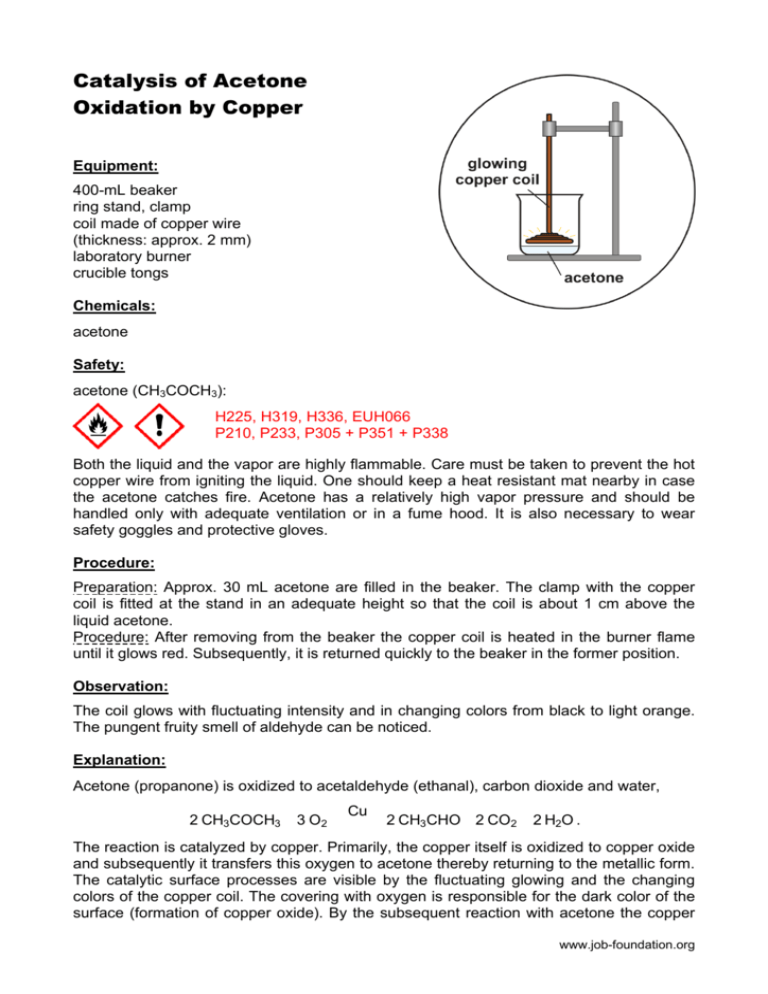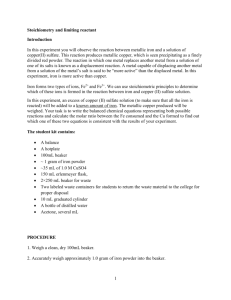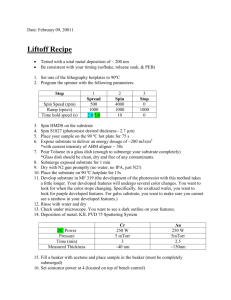Catalytic Oxidation of Acetone
advertisement

Catalysis of Acetone Oxidation by Copper Equipment: 400-mL beaker ring stand, clamp coil made of copper wire (thickness: approx. 2 mm) laboratory burner crucible tongs Chemicals: acetone Safety: acetone (CH3COCH3): H225, H319, H336, EUH066 P210, P233, P305 + P351 + P338 Both the liquid and the vapor are highly flammable. Care must be taken to prevent the hot copper wire from igniting the liquid. One should keep a heat resistant mat nearby in case the acetone catches fire. Acetone has a relatively high vapor pressure and should be handled only with adequate ventilation or in a fume hood. It is also necessary to wear safety goggles and protective gloves. Procedure: Preparation: Approx. 30 mL acetone are filled in the beaker. The clamp with the copper coil is fitted at the stand in an adequate height so that the coil is about 1 cm above the liquid acetone. Procedure: After removing from the beaker the copper coil is heated in the burner flame until it glows red. Subsequently, it is returned quickly to the beaker in the former position. Observation: The coil glows with fluctuating intensity and in changing colors from black to light orange. The pungent fruity smell of aldehyde can be noticed. Explanation: Acetone (propanone) is oxidized to acetaldehyde (ethanal), carbon dioxide and water, 2 CH3COCH3 3 O2 Cu 2 CH3CHO 2 CO2 2 H2O . The reaction is catalyzed by copper. Primarily, the copper itself is oxidized to copper oxide and subsequently it transfers this oxygen to acetone thereby returning to the metallic form. The catalytic surface processes are visible by the fluctuating glowing and the changing colors of the copper coil. The covering with oxygen is responsible for the dark color of the surface (formation of copper oxide). By the subsequent reaction with acetone the copper www.job-foundation.org surface becomes bright again because of the transfer of the oxygen and begins to glow because of the released reaction energy. According to Robert D. Whitaker and Thurman McGarian (J. Chem. Educ., 53 (1976) 776), the reaction also produces ketene gas (CH2CO) toxic by inhalation and methane as intermediates which are oxidized to carbon dioxide and water. Disposal: The remaining acetone is collected in a container for halogen-free organic solvents or alternatively, it can be redistilled. www.job-foundation.org








